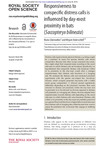Please use this identifier to cite or link to this item:
http://lib.hpu.edu.vn/handle/123456789/21913Full metadata record
| DC Field | Value | Language |
|---|---|---|
| dc.contributor.author | Eckenweber, Maria | en_US |
| dc.contributor.author | Knörnschild, Mirjam | en_US |
| dc.date.accessioned | 2016-07-04T03:49:05Z | |
| dc.date.available | 2016-07-04T03:49:05Z | |
| dc.date.issued | 2016 | en_US |
| dc.identifier.other | HPU4160395 | en_US |
| dc.identifier.uri | https://lib.hpu.edu.vn/handle/123456789/21913 | - |
| dc.description.abstract | Distress calls signal extreme physical distress, e.g. being caught by a predator. In many bat species, distress calls attract conspecifics. Because bats often occupy perennial day-roosts, they might adapt their responsiveness according to the social relevance in which distress calls are broadcast. Specifically, we hypothesized that conspecific distress calls broadcast within or in proximity to the day-roost would elicit a stronger responsiveness than distress calls broadcast at a foraging site. We analysed the distress calls and conducted playback experiments with the greater sac-winged bat, Saccopteryx bilineata, which occupies perennial day-roosts with a stable social group composition. | en_US |
| dc.format.extent | 8 p. | en_US |
| dc.format.mimetype | application/pdf | - |
| dc.language.iso | en | en_US |
| dc.subject | Biology | en_US |
| dc.subject | Behaviour | en_US |
| dc.subject | Distress calls | en_US |
| dc.subject | Social relevance | en_US |
| dc.subject | Location-dependent responsiveness | en_US |
| dc.subject | Social call | en_US |
| dc.subject | Chiroptera | en_US |
| dc.title | Responsiveness to conspecific distress calls is influenced by day roost proximity in bats | en_US |
| dc.type | Article | en_US |
| dc.size | 615KB | en_US |
| dc.department | Education | en_US |
| Appears in Collections: | Education | |
Files in This Item:
| File | Description | Size | Format | |
|---|---|---|---|---|
| 0278_Responsivenesstoconspecificdistress.pdf Restricted Access | 615.4 kB | Adobe PDF |  View/Open Request a copy |
Items in DSpace are protected by copyright, with all rights reserved, unless otherwise indicated.
